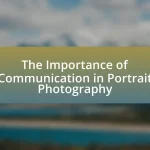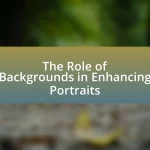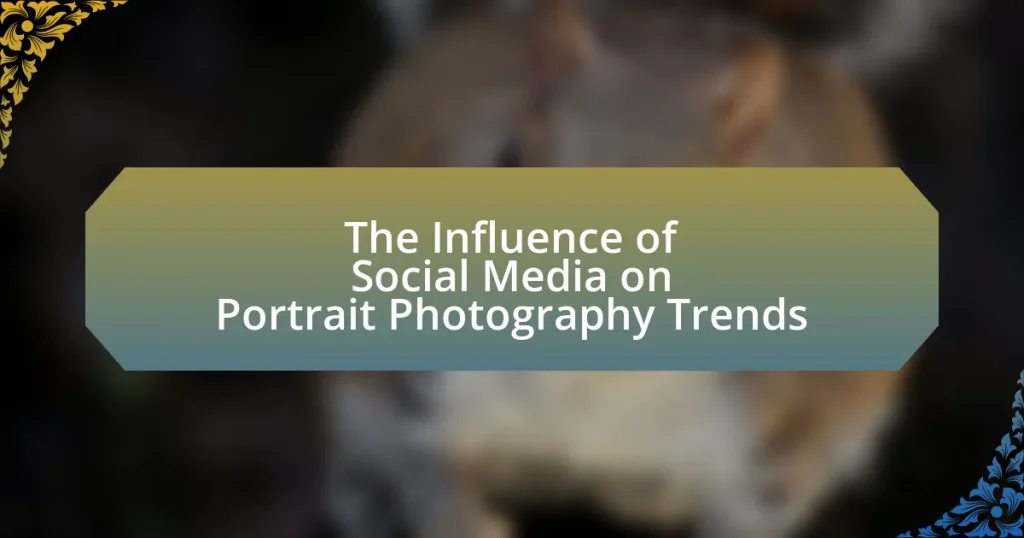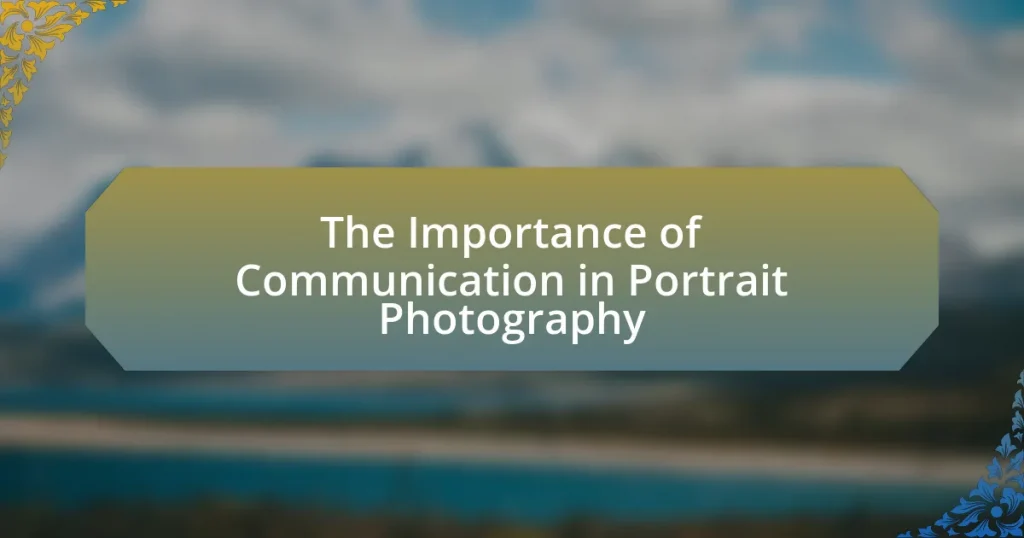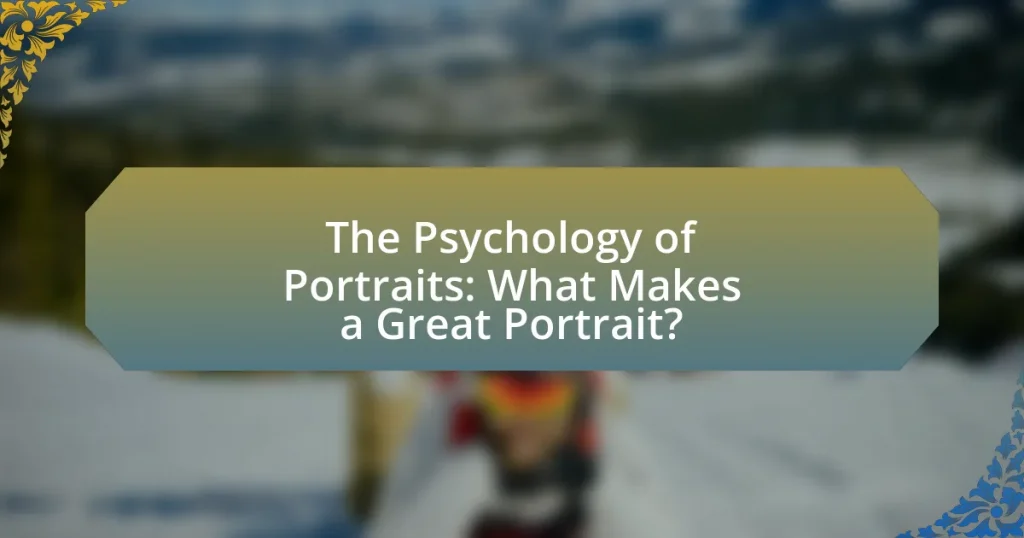The article examines the significant influence of social media on portrait photography trends, highlighting how platforms like Instagram and TikTok shape aesthetics, accessibility, and audience engagement. It discusses the democratization of portrait photography through user-generated content and the impact of hashtags on visibility and style evolution. Key trends include the rise of candid and lifestyle photography, vibrant color usage, and the emphasis on diversity and authenticity. Additionally, the article explores how social media alters marketing strategies for photographers, provides networking opportunities, and predicts future developments driven by emerging technologies such as artificial intelligence and augmented reality.
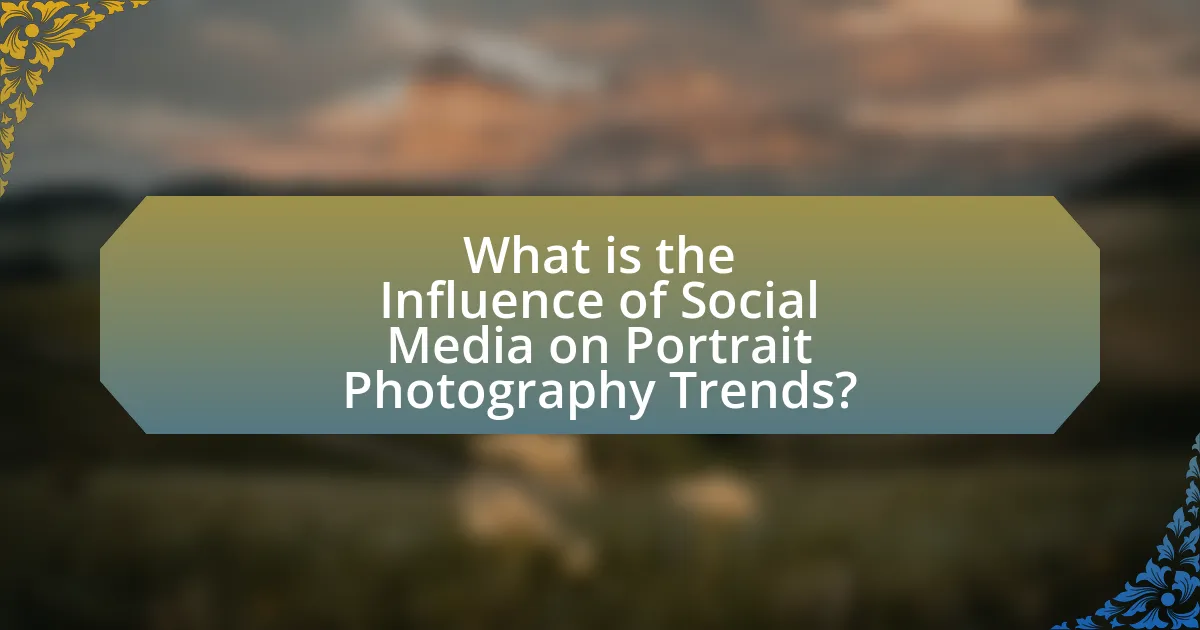
What is the Influence of Social Media on Portrait Photography Trends?
Social media significantly influences portrait photography trends by shaping aesthetics, accessibility, and audience engagement. Platforms like Instagram and TikTok promote specific styles, such as candid shots and vibrant colors, which photographers adopt to attract viewers. The rise of influencers has also democratized portrait photography, allowing diverse voices and styles to emerge, as seen in the popularity of user-generated content. According to a study by the Pew Research Center, 72% of adults use social media, indicating a vast audience for portrait photography, which encourages photographers to tailor their work to current trends and audience preferences. This dynamic interaction between social media and portrait photography continues to evolve, driving innovation and creativity in the field.
How has social media changed the landscape of portrait photography?
Social media has transformed portrait photography by democratizing access to photography and enabling instant sharing and feedback. Platforms like Instagram and Facebook allow photographers to showcase their work to a global audience, leading to increased visibility and opportunities for both amateur and professional photographers. According to a 2021 survey by the Pew Research Center, 72% of adults use social media, which has created a vast market for portrait photography as individuals seek to curate their online identities through high-quality images. This shift has also influenced trends, with styles such as candid and lifestyle photography gaining popularity, reflecting the desire for authenticity in personal branding.
What specific social media platforms are most influential in this change?
Instagram and TikTok are the most influential social media platforms driving changes in portrait photography trends. Instagram’s visual-centric design and features like Stories and Reels encourage photographers to showcase their work creatively, leading to trends such as candid shots and vibrant color palettes. TikTok, with its short-form video content, has popularized dynamic photography styles and editing techniques, influencing how photographers engage with their audience. The rise of hashtags and viral challenges on these platforms further amplifies trends, making them pivotal in shaping contemporary portrait photography.
How do user-generated content and hashtags impact portrait photography trends?
User-generated content and hashtags significantly shape portrait photography trends by increasing visibility and engagement within the photography community. When users share their own portraits using specific hashtags, they create a collective visual language that influences styles, poses, and themes. For instance, the hashtag #PortraitPhotography has amassed millions of posts on platforms like Instagram, showcasing diverse interpretations and techniques that inspire both amateur and professional photographers. This phenomenon not only democratizes the art form but also drives trends, as popular styles often emerge from viral user-generated content, leading to shifts in what is considered fashionable or desirable in portrait photography.
Why is social media important for portrait photographers?
Social media is important for portrait photographers because it serves as a powerful platform for showcasing their work and reaching potential clients. By sharing high-quality images and engaging content, photographers can build a personal brand and establish a following, which is crucial in a competitive industry. According to a survey by the Pew Research Center, 69% of adults in the U.S. use social media, making it an essential tool for visibility and marketing. Additionally, social media allows for direct interaction with audiences, enabling photographers to receive feedback and foster relationships that can lead to referrals and bookings.
What opportunities does social media provide for exposure and networking?
Social media provides significant opportunities for exposure and networking, particularly in the realm of portrait photography. Platforms like Instagram and Facebook allow photographers to showcase their work to a global audience, increasing visibility and attracting potential clients. According to a survey by the Pew Research Center, 69% of adults in the U.S. use social media, which facilitates connections with other photographers, industry professionals, and art enthusiasts. This connectivity can lead to collaborations, mentorships, and increased business opportunities, as users can engage directly through comments, shares, and direct messages. Additionally, social media algorithms often promote popular content, further enhancing exposure for photographers who create engaging and visually appealing work.
How does social media affect the way photographers market their work?
Social media significantly alters how photographers market their work by providing platforms for direct engagement with audiences and showcasing portfolios. Photographers can utilize platforms like Instagram and Facebook to share their images, connect with potential clients, and build a personal brand, which is crucial in a visually-driven industry. According to a 2021 survey by the Pew Research Center, 69% of adults in the U.S. use social media, indicating a vast audience for photographers to reach. This accessibility allows photographers to promote their work more effectively than traditional marketing methods, such as print advertising. Furthermore, social media algorithms favor visually appealing content, which can enhance visibility and attract more followers, leading to increased business opportunities.
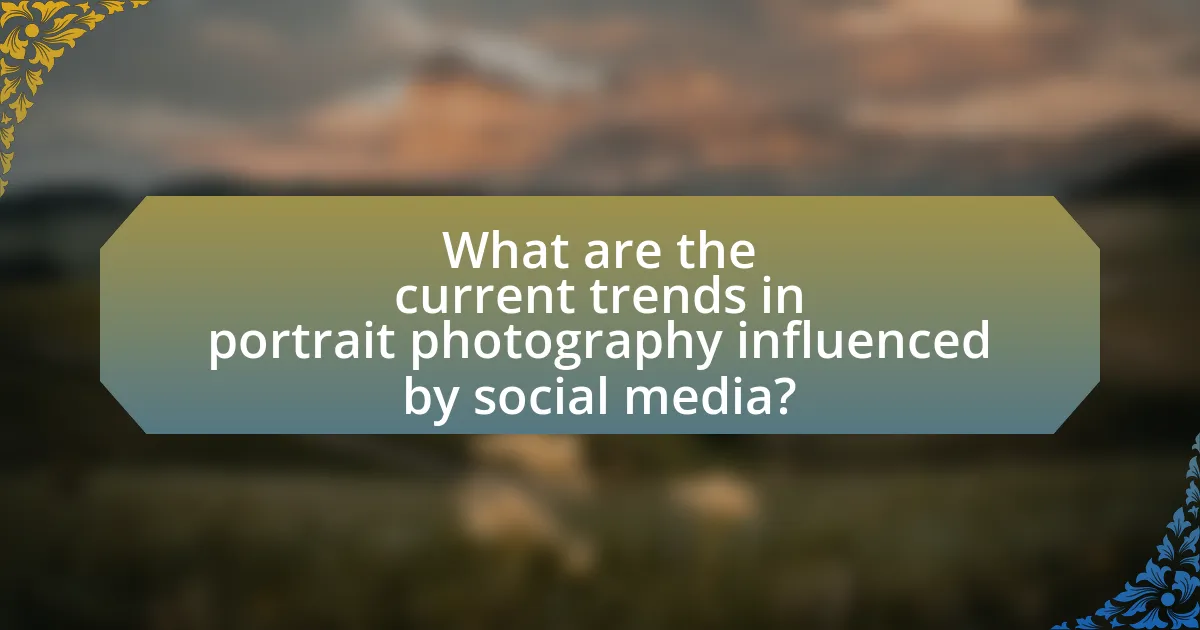
What are the current trends in portrait photography influenced by social media?
Current trends in portrait photography influenced by social media include the rise of candid and lifestyle shots, the use of vibrant colors and unique lighting techniques, and the incorporation of diverse subjects and body positivity. Candid photography has gained popularity as it captures authentic moments, resonating with audiences seeking relatability. Vibrant colors and creative lighting enhance visual appeal, aligning with the aesthetic preferences seen on platforms like Instagram. Additionally, the emphasis on diversity reflects a broader cultural shift towards inclusivity, with photographers showcasing a range of identities and experiences, which has been supported by social media campaigns advocating for representation.
What styles of portrait photography are gaining popularity on social media?
Styles of portrait photography gaining popularity on social media include candid photography, environmental portraits, and minimalistic portraits. Candid photography captures spontaneous moments, appealing to audiences for its authenticity, while environmental portraits showcase subjects in their natural surroundings, providing context and storytelling elements. Minimalistic portraits focus on simplicity and clean lines, often emphasizing the subject against a plain background, which resonates well with modern aesthetics. These styles reflect current trends in visual storytelling and audience preferences on platforms like Instagram and TikTok, where engagement is driven by relatable and visually striking content.
How do aesthetic choices in portrait photography reflect social media trends?
Aesthetic choices in portrait photography reflect social media trends by prioritizing visual appeal and engagement to attract viewers. For instance, the use of vibrant colors, unique compositions, and specific filters aligns with the aesthetics popularized on platforms like Instagram, where eye-catching images garner more likes and shares. Research indicates that images with high saturation and contrast are more likely to be engaged with on social media, as they stand out in crowded feeds. This trend is further supported by the rise of influencers who curate their feeds with cohesive color palettes and styles, demonstrating that aesthetic choices are not only artistic but also strategic for maximizing social media presence.
What role does editing and filters play in shaping these trends?
Editing and filters significantly shape portrait photography trends by enhancing visual appeal and creating distinct styles. These tools allow photographers to manipulate colors, contrast, and sharpness, resulting in images that align with current aesthetic preferences. For instance, the rise of vibrant, high-contrast images on platforms like Instagram has led to a trend favoring bold edits that attract viewer engagement. According to a study by the Pew Research Center, 72% of teens use Instagram, where curated and edited images dominate, influencing the overall style of portrait photography. This trend reflects a shift towards polished, visually striking content that resonates with audiences, ultimately driving the popularity of specific editing techniques and filter applications in the photography community.
How do social media challenges and trends impact portrait photography?
Social media challenges and trends significantly influence portrait photography by shaping the styles, themes, and techniques that photographers adopt. For instance, viral challenges often encourage photographers to experiment with specific aesthetics or concepts, such as the “10-Year Challenge,” which prompted users to share side-by-side portraits showcasing their evolution over a decade. This trend not only increased engagement but also inspired photographers to explore creative ways to depict transformation and nostalgia in their work. Additionally, platforms like Instagram and TikTok serve as visual trendsetters, where popular filters and editing styles can dictate the look of portrait photography, leading to a homogenization of styles as photographers aim to align with current trends for visibility and engagement.
What are some popular photography challenges on social media?
Some popular photography challenges on social media include the 365 Challenge, where participants take and share a photo every day for a year, and the 52-Week Challenge, which encourages one photo per week based on specific themes. Additionally, the Self-Portrait Challenge prompts photographers to capture their own likeness creatively, while the Black and White Challenge focuses on monochromatic photography. These challenges foster community engagement and creativity, as evidenced by the millions of posts tagged with related hashtags on platforms like Instagram, demonstrating their widespread popularity and influence on photography trends.
How do these challenges influence photographers’ creativity and techniques?
Challenges in social media, such as oversaturation and the pressure for engagement, significantly influence photographers’ creativity and techniques. Photographers often adapt by developing unique styles or concepts to stand out in a crowded market, leading to innovative approaches in composition, lighting, and subject matter. For instance, the need to capture attention quickly has resulted in the use of bold colors and striking visuals, as evidenced by the rise of vibrant aesthetic trends on platforms like Instagram. Additionally, the demand for consistent content encourages photographers to experiment with new techniques, such as incorporating storytelling elements or utilizing advanced editing software, thereby enhancing their skill set and artistic expression.
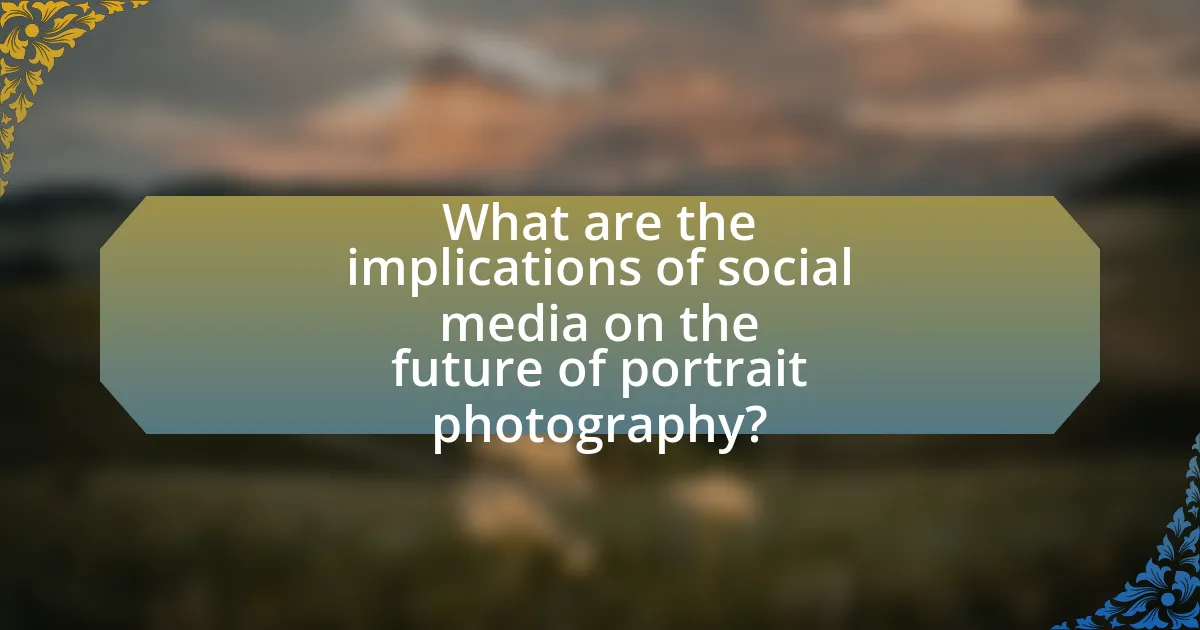
What are the implications of social media on the future of portrait photography?
Social media significantly influences the future of portrait photography by shaping trends, accessibility, and audience engagement. Platforms like Instagram and TikTok prioritize visual content, leading to an increased demand for innovative and diverse portrait styles. This shift encourages photographers to adapt their techniques and aesthetics to capture attention in a crowded digital space. Additionally, social media democratizes portrait photography, allowing emerging photographers to showcase their work and gain recognition without traditional gatekeeping. According to a 2021 report by the Pew Research Center, 72% of adults use social media, highlighting its role in shaping public perception and trends in photography. As a result, the future of portrait photography will likely continue to evolve rapidly, driven by social media’s influence on creativity and audience interaction.
How might emerging technologies affect portrait photography trends on social media?
Emerging technologies are likely to significantly influence portrait photography trends on social media by enhancing image quality and enabling innovative editing techniques. For instance, advancements in artificial intelligence (AI) and machine learning allow for automated enhancements, such as background removal and facial retouching, which streamline the editing process and improve the overall aesthetic of portraits. According to a report by Adobe, 61% of photographers use AI tools to enhance their images, indicating a growing reliance on technology for creative expression. Additionally, augmented reality (AR) filters on platforms like Instagram and Snapchat enable users to apply dynamic effects to their portraits, fostering a trend toward more interactive and engaging content. This shift towards technology-driven creativity is reshaping how individuals present themselves and connect with audiences on social media.
What role will artificial intelligence play in portrait photography?
Artificial intelligence will significantly enhance portrait photography by automating processes such as image editing, subject recognition, and style transfer. AI algorithms can analyze facial features and expressions, allowing for precise adjustments in lighting, color correction, and background enhancement, which improves the overall quality of portraits. For instance, tools like Adobe Photoshop’s AI features can automatically retouch skin and enhance details, streamlining the workflow for photographers. Additionally, AI-driven applications can suggest optimal poses and compositions based on successful trends observed in social media, thus influencing the creative direction of portrait photography.
How could virtual reality and augmented reality change the way portraits are created and shared?
Virtual reality (VR) and augmented reality (AR) could revolutionize portrait creation and sharing by enabling immersive experiences and interactive features. VR allows users to create 3D portraits in virtual environments, enhancing artistic expression and creativity. For instance, artists can manipulate virtual canvases and experiment with dimensions and perspectives that are impossible in traditional photography. AR, on the other hand, can overlay digital elements onto real-world portraits, allowing for dynamic interactions, such as animated backgrounds or filters that change in real-time.
The integration of these technologies can also facilitate sharing; users can showcase their portraits in virtual galleries or social media platforms that support AR features, increasing engagement and reach. According to a report by Statista, the global AR and VR market is projected to reach $209.2 billion by 2022, indicating a growing trend that could significantly impact how portraits are perceived and disseminated. This shift towards immersive and interactive portraiture aligns with the evolving landscape of social media, where visual content is paramount.
What best practices should photographers follow to leverage social media effectively?
Photographers should consistently post high-quality images and engage with their audience to leverage social media effectively. Regularly sharing visually appealing content attracts followers and showcases their skills, while interaction through comments and messages builds a community and fosters loyalty. According to a study by Hootsuite, posts with images receive 94% more views than those without, highlighting the importance of visual content. Additionally, using relevant hashtags can increase visibility; research indicates that posts with at least one hashtag can increase engagement by 12.6%. By following these practices, photographers can enhance their online presence and connect with potential clients.
How can photographers create engaging content that resonates with their audience?
Photographers can create engaging content that resonates with their audience by understanding their audience’s preferences and utilizing storytelling techniques in their work. By analyzing social media trends, photographers can identify popular themes, styles, and subjects that attract viewers. For instance, a study by the Pew Research Center indicates that 72% of adults use social media, making it a vital platform for photographers to showcase their work and connect with potential clients. Additionally, incorporating personal narratives or emotional elements into photographs can enhance relatability, as research shows that content with a personal touch tends to generate higher engagement rates.
What strategies can photographers use to build a strong online presence?
Photographers can build a strong online presence by utilizing social media platforms effectively, creating a professional website, and engaging with their audience. Social media platforms like Instagram and Facebook allow photographers to showcase their work, connect with potential clients, and participate in photography communities. A professional website serves as a portfolio and a hub for contact information, enhancing credibility. Engaging with the audience through comments, direct messages, and interactive content fosters relationships and encourages word-of-mouth referrals. According to a survey by Hootsuite, 73% of marketers believe that their efforts through social media marketing have been “somewhat effective” or “very effective” for their business, highlighting the importance of these strategies in establishing an online presence.
